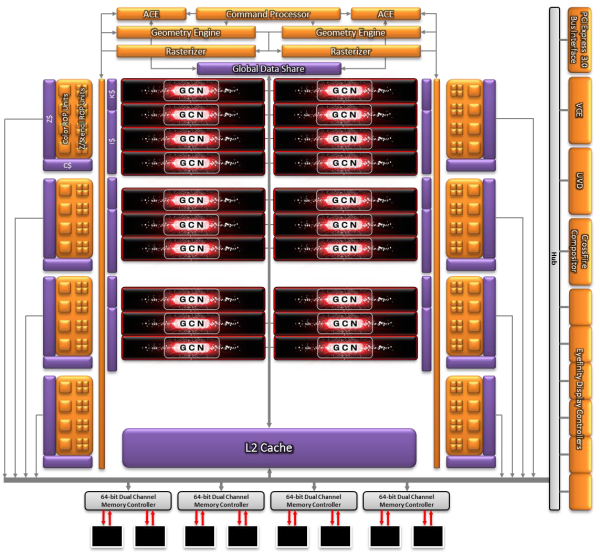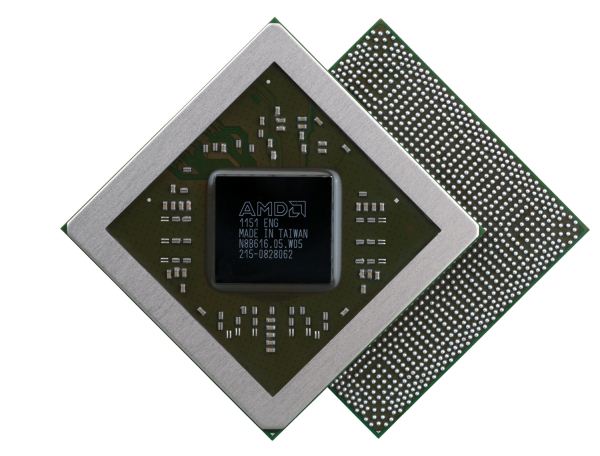AMD Radeon HD 7870 GHz Edition & Radeon HD 7850 Review: Rounding Out Southern Islands
by Ryan Smith on March 5, 2012 12:01 AM ESTIn 2009-2010, AMD launched the entire 4 chip Evergreen series in 6 months. By previous standards this was a quick pace for a new design, especially since AMD had not previously attempted a 4 chip launch in such a manner. Now in 2012 AMD’s Southern Islands team is hard at work at wrapping up their own launch with new aspirations on quickness. Evergreen may have launched 4 chips in 6 months, but this month AMD will be completing the 3 chip Southern Islands launch in half the time – 3 chips in a mere 3 months.
To that end today AMD is taking the wraps off the final piece of the Southern Islands puzzle: Pitcairn. The middle child of the family, it will be the basis of AMD’s $250+ enthusiast segment Radeon HD 7800 series. We’ve seen AMD capture the high-end with the 7900 series and struggle to control the mainstream market with the 7700 series, but how does the 7800 series fare amidst AMD’s lead in deploying 28nm GPUs? Let’s find out.
| AMD GPU Specification Comparison | |||||||
| AMD Radeon HD 7870 | AMD Radeon HD 7850 | AMD Radeon HD 6970 | AMD Radeon HD 6950 | AMD Radeon HD 5870 | |||
| Stream Processors | 1280 | 1024 | 1536 | 1408 | 1600 | ||
| Texture Units | 80 | 64 | 96 | 88 | 80 | ||
| ROPs | 32 | 32 | 32 | 32 | 32 | ||
| Core Clock | 1000MHz | 860MHz | 880MHz | 800MHz | 850MHz | ||
| Memory Clock | 4.8GHz GDDR5 | 4.8GHz GDDR5 | 5.5GHz GDDR5 | 5.0GHz GDDR5 | 4.8GHz GDDR5 | ||
| Memory Bus Width | 256-bit | 256-bit | 256-bit | 256-bit | 256-bit | ||
| Frame Buffer | 2GB | 2GB | 2GB | 2GB | 1GB | ||
| FP64 | 1/16 | 1/16 | 1/4 | 1/4 | 1/5 | ||
| Transistor Count | 2.8B | 2.8B | 2.64B | 2.64B | 2.15B | ||
| PowerTune Limit | 190W | 150W | 250W | 200W | N/A | ||
| Manufacturing Process | TSMC 28nm | TSMC 28nm | TSMC 40nm | TSMC 40nm | TSMC 40nm | ||
| Architecture | GCN | GCN | VLIW4 | VLIW4 | VLIW5 | ||
| Price Point | $350 | $250 | N/A | N/A | N/A | ||
So what exactly is Pitcairn? In a nutshell, take Cape Verde (7700) and double it, and you have Pitcairn. Pitcairn has twice the number of CUs, twice the number of ROPs, twice the memory bandwidth, and of particular importance twice as many geometry engines on the frontend. This works out to 1280 SPs among 20 CUs – organized as a doubling Cape Verde’s interesting 4/3/3 configuration – 80 texture units, 32 ROPs, 512KB L2 cache, and a 256-bit memory bus. Compared to Tahiti, Pitcairn still has 12 fewer CUs and as a result less shader and texturing performance along with the narrower memory bus, but it has the same number of ROPs and the same frontend as its bigger brother, which as we’ll see creates some very interesting situations.
On the functionality side of things, the Cape Verde comparisons continue. As with all Southern Islands family parts, Pitcairn supports things such as DX10+ SSAA, PowerTune, Fast HDMI support, partially resident textures, D3D 11.1 support, and the still-AWOL Video Codec Engine (VCE). FP64 support is once again present, and like Cape Verde it’s a performance-limited implementation for compatibility and software development purposes, with FP64 performance limited to 1/16th FP32 performance.
AMD’s Pitcairn cards will be the Radeon HD 7870 GHz Edition and the Radeon HD 7850. The 7870 is a full Pitcairn, clocked at 1000MHz core and paired with 2GB of GDDR5 running at 4.8GHz. It has a PowerTune limit of 190W while AMD puts its typical board power draw closer to 175, meanwhile idle power consumption is around 10W with a long idle of 3W like the rest of Southern Islands. As for the 7850 it’s the typical lower tier part, featuring 16 active CUs (1024 SPs), an 860MHz core clock, and the same 2GB of GDDR5 running at 4.8GHz as its counterpart, giving it roughly 68% the shading/texturing performance and 86% of the ROP & frontend performance of the 7870. The PowerTune limit is 150W with a typical board power of 130W, and the same 10W/3W idle power consumption as the 7870.
Altogether the 7800 series isn’t just the successor to the Barts based 6800 series in name but also the successor to the 6800 in design. This includes not only power consumption, with one card being a sub-150W part, but also with regards to things such as CrossFire, where it features a single CF connector. Interestingly enough even though Barts was already a fairly small chip for its performance, Pitcairn takes this one step further with a die size of 212mm2, which in turn contains 2.8B transistors, only 160M more than Cayman. As we’ll see when we get to our benchmarks, this makes Pitcairn a surprisingly small chip given its 6970+ performance.
Speaking of the 6970, let’s talk about the 7800 series’ competition. As AMD began winding down Cayman (6900 series) almost immediately with the launch of the 7900 series, at this point the 6900 market has effectively dried up. Having taken themselves out of competition with themselves, AMD’s only competition is NVIDIA’s lineup. From a performance and price basis the 7870 and 7850 don’t map particularly well to any specific NVIDIA products, but generally speaking they’re targeted against the GTX 570 and GTX 560 Ti respectively.
With AMD targeting the ~$320 570 and ~$210 560 Ti and given their conservative pricing on the rest of Southern Islands, it should come as no surprise that the 7800 series is priced equally conservatively. The 7870 will have an MSRP of $350, while the 7850 will have an MSRP of $250. With the 7800 series completing the launch of Southern Islands, this gives AMD a consistent price structure for the entire family: $550, $450, $350, $250, $159, and $109.
Finally, as far as availability goes this will be a delayed launch. AMD is formally unveiling the 7800 series today, but it will not go on sale until the 19th, 2 weeks from now. AMD has said that this is due to both CeBIT and the Game Developers Conference; AMD and their partners want to be able to show off the 7800 series to their respective attendees at those events, with both events being far too large to keep the 7800 under wraps. This delayed launch also means that partner cards aren’t quite ready yet, so we only have AMD’s reference cards on hand. We’ll be taking a look at partner cards later this month.
| Spring 2012 GPU Pricing Comparison | |||||
| AMD | Price | NVIDIA | |||
| Radeon HD 7950 | $450 | GeForce GTX 580 | |||
| Radeon HD 7870 | $350 | ||||
| $330 | GeForce GTX 570 | ||||
| Radeon HD 7850 | $250 | ||||
| $200 | GeForce GTX 560 Ti | ||||
| $179 | GeForce GTX 560 | ||||
| Radeon HD 7770 | $159 | ||||













173 Comments
View All Comments
Kiste - Monday, March 5, 2012 - link
So, how many people do you know who would spend a few hundred bucks for a performance "sidegrade" that saves them a few bucks per year on their energy bill?Price/performance is still the relevant metric for most people, with everything else being secondary. Not unimportant, but secondary. Noise can also be addressed on cards with high power draw by buying a card with a custom cooler or using a 3rd party cooler.
Kaboose - Monday, March 5, 2012 - link
Some people are just entering the market, some people are coming from 3+ generations ago, some people are looking for HTPC's that can game and need low power and low temp cards that provide solid performance. It isn't a sidegrade for someone who is coming from integrated graphics or maybe a 7800GT etc. It is easy to think that everyone who buys these types of GPU's are knowledgeable and already have high performing GPU's. But that just isn't the case a lot of the time. If you have a high end 5xxx or a mid-high range 6xxx GPU already then there is no reason to upgrade, frankly with the 68xx series AMD isn't looking to grab that market.Kiste - Monday, March 5, 2012 - link
If you're looking for great price/performance, there are plenty of cards that offer more bang for your bucks.If you're looking for raw performance, you look elsewhere, too.
Though I'll happily concede that the 7850/7870 are great absolutely fabulous for everyone who is building a "HTPC that can game".
medi01 - Monday, March 5, 2012 - link
And exactly where do you look for raw performance, pretty please? Maybe at nVidia 570, that costs 80$, consumes more energy yet is outperformed in most tests by 7850?Kiste - Monday, March 5, 2012 - link
Where would you look for raw performance? How about the 79xx line?And what the hell are you talking about anyway? The 7850 does not "outperform" the 570 in most tests, unless you're again back at comparing an overclocked card to a non-overclocked card. Most 570 cards can do a 15-20% OC easily, btw.
Hell, I bought my GTX570 about 12 months ago for €289. And I'm supposed to be blown away by something like the 7870 in 2012?
The GTX570 became available about 14 months ago. It took AMD 14 frigging month to come up with a card like the 7870 that is 9% faster on average at the same price point?
Gee, what a marvel of technology.
krumme - Monday, March 5, 2012 - link
570 is 250% larger and 9% slowerIts a giant leap
talk about marvel of technology
Your card is tech from stone age compared to a 7870.
Old tech is old
SlyNine - Monday, March 5, 2012 - link
I'm running a 5870 which is basically 75% the performance of a 7970, and I paid 379 for the 5870. Which is also 75% of the cost of a 7970. The price of a 7970 is basically the exact same price structure as the 2 1/2 year old 5870, So we are stuck where we were in 2009, yay.Yea we are sure moving forward...
morfinx - Monday, March 5, 2012 - link
75% performance of 7970 would mean that it's 33% faster than a 5870. And that's just not accurate. I have a 5870 as well, so I was paying a lot of attention on how much faster the 7970 is in various reviews. Everything I've read indicates that it's anywhere from 70-110% faster at 2560x1600 resolution (I run 3600x1920, so likely even even more of a difference). That's not even even considering the massive overclocking headroom of the 7970 vs barely any OC headroom of the 5870. Overclocked, a 7970 is easily twice as fast as a 5870.RaistlinZ - Monday, March 5, 2012 - link
This is true. I came from a 5870 to a 7970 and at 2560x1600 the 7970 is easily twice as fast.And that's even before overclocking. My 5870 could barely overclock for crap, whereas my 7970 overclocks 27% on core and 18% on memory.
SlyNine - Thursday, March 8, 2012 - link
Not according to Anandtechs benchmarks.